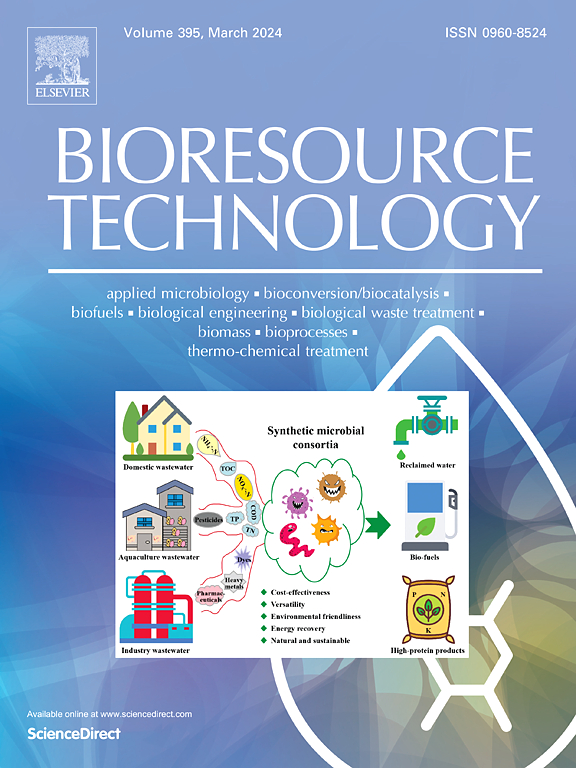利用 awamori 曲霉进行固态发酵,实现富含黑色素的中国蒸馏废粮的升级再利用。
IF 9.7
1区 环境科学与生态学
Q1 AGRICULTURAL ENGINEERING
引用次数: 0
摘要
本研究调查了通过真菌固态发酵(SSF)对蒸馏废糟(DSG)(一种富含黑色素的中国白酒业副产品)进行升级再循环的情况。测试了两种真菌,即黑曲霉(Aspergillus oryzae)和泡盛曲霉(Aspergillus awamori),其中泡盛曲霉在废糟上的生长情况优于黑曲霉。使用 awamori 曲霉的 SSF 能使 DSG 提取物中的水溶性蛋白质和酚类化合物的浓度分别提高 46.5% 和 52.5%,并能使 DSG 中的类黑色素含量降低 73.5%(重量百分比),这表明 awamori 曲霉能代谢类黑色素。以分离出的 DSG 类黑色素为唯一碳源和氮源进行浸没发酵(SmF)证实了这一观察结果。发酵 3 天后,A. awamori 和 A. oryzae 的生物量分别达到 2.5 克/升和 1.5 克/升,黑色素淬灭率分别为 24.4% 和 12.4%。A. awamori 的 SmF 还释放出游离阿拉伯糖、葡萄糖和木糖。这些数据突显了将类黑色素转化为可食用菌丝资源的可能性,可能适用于各种富含类黑色素的食品副产品。本文章由计算机程序翻译,如有差异,请以英文原文为准。

Upcycling of melanoidin-rich Chinese distilled spent grain through solid-state fermentation by Aspergillus awamori
This study investigated the upcycling of distilled spent grain (DSG), a melanoidin-rich by-product of the Chinese liquor industry, via fungal solid-state fermentation (SSF). Two fungi, Aspergillus oryzae and Aspergillus awamori, were tested, with A. awamori growing better on DSG than A. oryzae. SSF with A. awamori increased the concentration of water-soluble protein and phenolic compounds in DSG extracts by 46.5 % and 52.5 %, respectively, and reduced melanoidin level by 73.5 % w/w of DSG, suggesting A. awamori could metabolize melanoidins. Submerged fermentation (SmF) using isolated DSG melanoidins as sole carbon and nitrogen sources confirmed this observation. After 3 days of fermentation, A. awamori and A. oryzae biomass reached 2.5 g/L and 1.5 g/L, quenching melanoidin color by 24.4 % and 12.4 %, respectively. SmF by A. awamori also released free arabinose, glucose, and xylose. Data highlighted the possibility of converting melanoidins into edible mycelia resources, potentially applicable to various melanoidin-rich food by-products.
求助全文
通过发布文献求助,成功后即可免费获取论文全文。
去求助
来源期刊

Bioresource Technology
工程技术-能源与燃料
CiteScore
20.80
自引率
19.30%
发文量
2013
审稿时长
12 days
期刊介绍:
Bioresource Technology publishes original articles, review articles, case studies, and short communications covering the fundamentals, applications, and management of bioresource technology. The journal seeks to advance and disseminate knowledge across various areas related to biomass, biological waste treatment, bioenergy, biotransformations, bioresource systems analysis, and associated conversion or production technologies.
Topics include:
• Biofuels: liquid and gaseous biofuels production, modeling and economics
• Bioprocesses and bioproducts: biocatalysis and fermentations
• Biomass and feedstocks utilization: bioconversion of agro-industrial residues
• Environmental protection: biological waste treatment
• Thermochemical conversion of biomass: combustion, pyrolysis, gasification, catalysis.
 求助内容:
求助内容: 应助结果提醒方式:
应助结果提醒方式:


